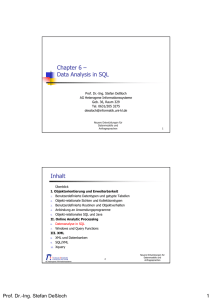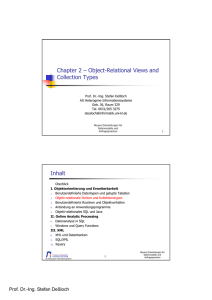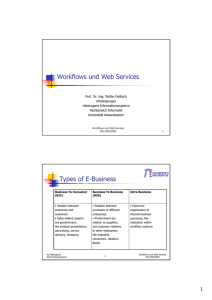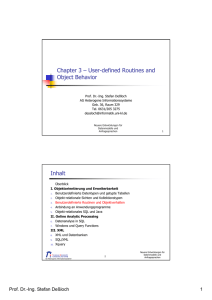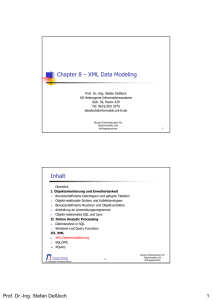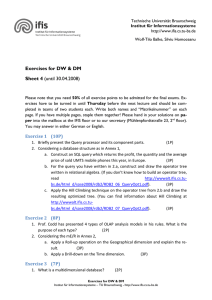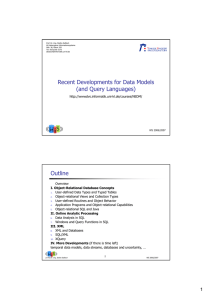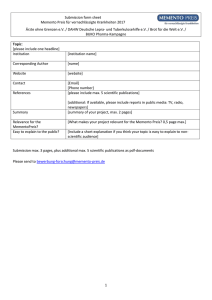pdf-full
Werbung
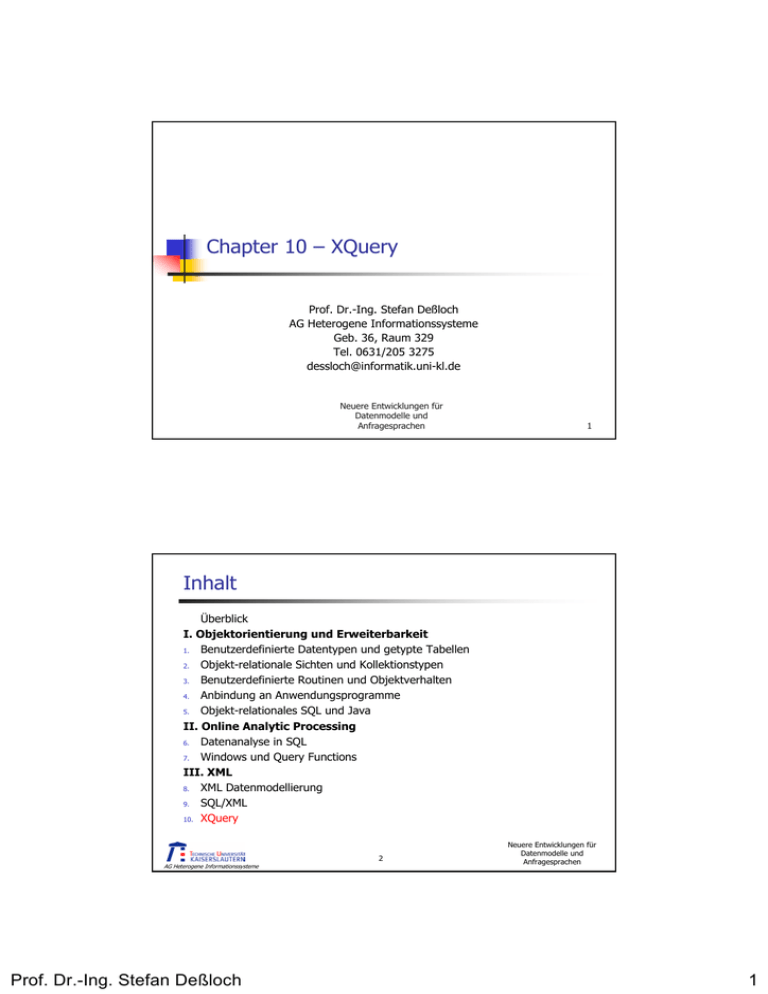
Chapter 10 – XQuery Prof. Dr.-Ing. Stefan Deßloch AG Heterogene Informationssysteme Geb. 36, Raum 329 Tel. 0631/205 3275 [email protected] Neuere Entwicklungen für Datenmodelle und Anfragesprachen 1 Inhalt Überblick I. Objektorientierung und Erweiterbarkeit 1. Benutzerdefinierte Datentypen und getypte Tabellen 2. Objekt-relationale Sichten und Kollektionstypen 3. Benutzerdefinierte Routinen und Objektverhalten 4. Anbindung an Anwendungsprogramme 5. Objekt-relationales SQL und Java II. Online Analytic Processing 6. Datenanalyse in SQL 7. Windows und Query Functions III. XML 8. XML Datenmodellierung 9. SQL/XML 10. XQuery 2 AG Heterogene Informationssysteme Prof. Dr.-Ing. Stefan Deßloch Neuere Entwicklungen für Datenmodelle und Anfragesprachen 1 Why do we need a new query language? Relational Data, SQL flat (rows and columns), use foreign keys, structured types for hierarchical data data is uniform, repetitive XML info schema for meta data nested, need to search for something at an arbitrary level (//*[@color = "Red"]) data is highly variable, self-describing uniform query results meta data distributed throughout doc queries may need to access data and meta data: "tag name equals content" //*[name(.) = string(.)] heterogenous query results severe structural transformations required rows in a table are unordered data is usually dense NULL for missing/inapplicable data invert a hierarchy elements in document are ordered needs to be preserved query based on order, position output order specification at multiple levels in the hierarchy data can be sparse empty or absent elements 3 AG Heterogene Informationssysteme Neuere Entwicklungen für Datenmodelle und Anfragesprachen XQuery: Language Requirements XML elements have attributes as well as content Content model of an XML element-type is much more flexible than in the relational setting (as described by an XML Schema) Choices between alternative contents, variable numbers of repetitions Mixed content (subelements mixed with text) Î An XML query language must be able to: Query deeply nested and heterogeneous structures Query metadata as well as user data Search for objects by absolute and relative order Preserve order of objects in input documents Impose new ordering at multiple levels of output Handle missing data and sparse data Preserve or transform the structure of a document Exploit references to unknown or heterogeneous types Easily define recursive functions Provide a very flexible data definition facility 4 AG Heterogene Informationssysteme Prof. Dr.-Ing. Stefan Deßloch Neuere Entwicklungen für Datenmodelle und Anfragesprachen 2 XQuery XQuery is a general purpose query language for XML data Currently being standardized by the World Wide Web Consortium (W3C) XQuery is derived from the Quilt (“Quilt” refers both to the origin of the language and to its use in “knitting ” together heterogeneous query language, which itself borrows from XPath: a concise language for navigating in trees XML-QL: a powerful language for generating new structures SQL: a database language based on a series of keyword-clauses: SELECT - FROM – WHERE OQL: a functional language in which many kinds of expressions can be nested with full generality data sources) Neuere Entwicklungen für Datenmodelle und Anfragesprachen 5 AG Heterogene Informationssysteme Tree Model of XML Data Query and transformation languages are based on a tree model of XML data An XML document is modeled as a tree, with nodes corresponding to elements and attributes Several types of nodes: Document, Element, Attribute, Text, Namespace, Comment, Processing Instruction D E E E T E A T A T T T Prof. Dr.-Ing. Stefan Deßloch E A T 6 AG Heterogene Informationssysteme A E Neuere Entwicklungen für Datenmodelle und Anfragesprachen 3 Example <?xml version = "1.0"?> <!-- Requires one trained person --> <procedure title = "Removing a light bulb"> <time unit = "sec">15</time> <step>Grip bulb.</step> <step> Rotate it <warning>slowly</warning> counterclockwise. time </step> E </procedure> D procedure C E A title="Removing a light bulb" step step A E unit="sec" E warning T T 15 Grip bulb. T E Rotate it T counterclockwise. T slowly 7 AG Heterogene Informationssysteme Neuere Entwicklungen für Datenmodelle und Anfragesprachen XQuery Data Model Builds on a tree-based model, but extends it to support sequences of items A value is an ordered sequence of zero or more items cannot be nested – all operations on sequences automatically "flatten" sequences An item is a node or an atomic value Atomic values are typed values There are seven kinds of nodes (see tree-based model) XML Schema simple types nodes have an identity each node has a typed value sequence of atomic values type may be unknown (anySimpleType) element and attribute nodes have a type annotation document order of nodes no distinction between an item and a sequence of length 1 can contain heterogenous values, are ordered, can be empty may contain duplicate nodes (see below) generated by validating the node Closure property XQuery expressions operate on/produce instances of the XQuery Data Model 8 AG Heterogene Informationssysteme Prof. Dr.-Ing. Stefan Deßloch Neuere Entwicklungen für Datenmodelle und Anfragesprachen 4 General XQuery Rules XQuery is a case-sensitive language Keywords are in lower-case Every expression has a value and no side effects Expressions are fully composable Expressions can raise errors Expressions (usually) propagate lower-level errors Comments look like this Exception: if-then-else (: This is an XQuery comment :) 9 AG Heterogene Informationssysteme Neuere Entwicklungen für Datenmodelle und Anfragesprachen XQuery Expressions Literals: "Hello" 47 4.7 4.7E-2 Constructed values: true() false() date("2002-03-15") Variables: $x Constructed sequences $a, $b is the same as ($a, $b) (1, (2, 3), (), (4)) is the same as 1, 2, 3, 4 5 to 8 is the same as 5, 6, 7, 8 10 AG Heterogene Informationssysteme Prof. Dr.-Ing. Stefan Deßloch Neuere Entwicklungen für Datenmodelle und Anfragesprachen 5 Path Expressions Inherited from XPath 1.0 An XPath expression maps a node (the context node) into a set of nodes is used to address (select) parts of documents using path expressions always returns a set of distinct nodes A path expression consists of one or more steps separated by “/” Result of path expression: set of values that along with their containing elements/attributes match the specified path E.g.: /bank-2/customer/customer-name evaluated on the bank-2 data returns <customer-name> Joe </ customer-name> < customer- name> Mary </ customer-name> E.g.:/bank-2/customer/cust-name/text( ) returns the same names, but without the enclosing tags 11 AG Heterogene Informationssysteme Neuere Entwicklungen für Datenmodelle und Anfragesprachen Path Expressions (cont.) The initial “/” denotes root of the document (above the top-level tag) In general, a step has three parts: The axis (direction of movement: child, descendant, parent, ancestor, following, preceding, attribute, … - 13 axes in all - ) A node test (type and/or name of qualifying nodes) Some predicates (refine the set of qualifying nodes) Path expressions are evaluated left to right Selection predicates may follow any step in a path, in [ ] Each step operates on the set of instances produced by the previous step E.g. /bank-2/account[balance > 400] returns account elements with a balance value greater than 400 /bank-2/account[balance] returns account elements containing a balance subelement Attributes are accessed using “@” E.g. /bank-2/account[balance > 400]/@account-number IDREF attributes are not dereferenced automatically (more on this later) returns the account numbers of those accounts with balance > 400 12 AG Heterogene Informationssysteme Prof. Dr.-Ing. Stefan Deßloch Neuere Entwicklungen für Datenmodelle und Anfragesprachen 6 XPath Axes Supported in XQuery Supported: child descendant attribute self descendant-or-self parent Optionally supported (full axis feature): ancestor ancestor-or-self preceding preceding-sibling following following-sibling namespace Neuere Entwicklungen für Datenmodelle und Anfragesprachen 13 AG Heterogene Informationssysteme Path Expressions (cont.) The following examples use the abbreviated notation: Find the first item of every list that is under the context node .//list/item[1] Find the “lang” attribute of the parent of the context node ../@lang Find the last paragraph-child of the context node para[last()] Find all warning elements that are inside instruction elements //instruction//warning Find all elements that have an ID attribute //*[@ID] Find names of customers who have an order with today’s date //customer [order/date = today ( ) ] / name 14 AG Heterogene Informationssysteme Prof. Dr.-Ing. Stefan Deßloch path expressions use a notation similar to paths in a file system: / means “child” or “root” // means “descendant” . means “self” .. means “parent” * means “any” @ means “attribute” Neuere Entwicklungen für Datenmodelle und Anfragesprachen 7 Node Tests Name test Element, attribute name namespace:name – Matches <name> element nodes in the specified namespace namespace:* - Matches any element node in the specified namespace child::name, name – Matches <name> element nodes child::*, * - Matches any element node attribute::name, attribute::*, @* for matching based on attribute name child::bank:* - Matches any element node whose name is defined in bank namespace Node Type test comment() – Matches comment nodes text() – Matches text nodes processing-instruction() – Matches processing instructions processing-instruction('target') – Matches processing instructions with the specified target (<?target ...?>) element(), element(name), element(name, type) – Matches element nodes node() – Matches any node 15 AG Heterogene Informationssysteme Neuere Entwicklungen für Datenmodelle und Anfragesprachen Predicates Boolean expressions: book[author = "Mark Twain"] Numeric expressions: Existence tests: chapter[2] book[appendix] person[@married] (Tests existence, not value!) Predicates can be used in path expressions: //book[author = "Mark Twain"]/chapter[2] ...and in other kinds of expressions: (1to 100)[. mod 5 = 0] 16 AG Heterogene Informationssysteme Prof. Dr.-Ing. Stefan Deßloch Neuere Entwicklungen für Datenmodelle und Anfragesprachen 8 XPath (cont.) XPath provides several functions The function count() at the end of a path counts the number of elements in the set generated by the path E.g. /bank-2/account[customer/count() > 2] Returns accounts with > 2 customers Also function for testing position (1, 2, ..) of node w.r.t. siblings Boolean connectives and and or and function not() can be used in predicates IDREFs can be referenced using function id() id() can also be applied to sets of references such as IDREFS and even to strings containing multiple references separated by blanks E.g. /bank-2/account/id(@owners) returns all customers referred to from the owners attribute of account elements 17 AG Heterogene Informationssysteme Neuere Entwicklungen für Datenmodelle und Anfragesprachen Path Expressions and Functions Path expressions can be used in various places, e.g.: In the For clause to bind variables In the Let clause to bind variables to results of path expressions $c/text() gives text content of an element without subelements/tags XQuery path expressions support the “=>” operator for dereferencing IDREFs Equivalent to the id( ) function of XPath, but simpler to use Can be applied to a set of IDREFs to get a set of results E.g.: "List hobbies of Denver employees“ /emp[location = "Denver"]/@hobbies => * Results may include <skiing>, <hiking>, etc. The function document(name) returns root of named document E.g. document(“bank-2.xml”)/bank-2/account 18 AG Heterogene Informationssysteme Prof. Dr.-Ing. Stefan Deßloch Neuere Entwicklungen für Datenmodelle und Anfragesprachen 9 Expressions (cont.) Combining sequences: union intersect except Arithmetic operators: + - * div idiv mod return sequences of distinct nodes in document order Extract typed value from node Multiple values => error If operand is ( ), return ( ) Supported for numeric and date/time types Comparison operators eq ne gt ge lt le compare single atomic values = != > >= < <= implied existential semantics is is not compare two nodes based on identity << >> compare two nodes based on document order 19 AG Heterogene Informationssysteme Neuere Entwicklungen für Datenmodelle und Anfragesprachen Logical Expressions Operators: and or Function: not( ) Return TRUE or FALSE (2-valued logic) "Early-out" semantics (need not evaluate both operands) Result depends on Effective Boolean Value of operands If operand is of type boolean, it serves as its own EBV If operand is ( ), zero, or empty string, EBV is FALSE In any other case, EBV is TRUE Note that EBV of a node is TRUE, regardless of its content (even if the content is FALSE)! 20 AG Heterogene Informationssysteme Prof. Dr.-Ing. Stefan Deßloch Neuere Entwicklungen für Datenmodelle und Anfragesprachen 10 Constructors To construct an element with a known name and content, use XML-like syntax: <book isbn = "12345"> <title>Huckleberry Finn</title> </book> If the content of an element or attribute must be computed, use a nested expression enclosed in { } <book isbn = "{$x}"> {$b/title } </book> If both the name and the content must be computed, use a computed constructor: element {name-expr} {content-expr} attribute {name-expr} {content-expr} 21 AG Heterogene Informationssysteme Neuere Entwicklungen für Datenmodelle und Anfragesprachen Validation of Constructed Elements An element constructor automatically validates the new element against "inscope schema definitions" Validation mode (default = lax) Results in a type annotation Can be generic: xs:anyType Strict: element must be defined in schema Lax: element must match schema definition if it exists Skip: ignore this element Mode is set in Prolog or by explicit Validate expression Validation context: Schema path inside which current node is validated Each constructed element adds its name to the context Can be overridden by an explicit Validate expression 22 AG Heterogene Informationssysteme Prof. Dr.-Ing. Stefan Deßloch Neuere Entwicklungen für Datenmodelle und Anfragesprachen 11 XQuery: The General Syntax Expression FLWOR FOR_clause LET_clause WHERE_clause ORDER_BY_clause FOR clause, LET clause generate list of tuples of bound variables (order preserving) by RETURN_clause iterating over a set of nodes (possibly specified by an XPath expression), or binding a variable to the result of an expression WHERE clause applies a predicate to filter the tuples produced by FOR/LET ORDER BY clause imposes order on the surviving tuples RETURN clause is executed for each surviving tuple, generates ordered list of outputs Associations to SQL query expressions for Ù SQL from where Ù SQL where order by Ù SQL order by return Ù SQL select let allows temporary variables, and has no equivalent in SQL 23 AG Heterogene Informationssysteme Neuere Entwicklungen für Datenmodelle und Anfragesprachen FLWOR - Examples Simple FLWR expression in XQuery Find all accounts with balance > 400, with each result enclosed in an <accountnumber> .. </account-number> tag for $x in /bank-2/account let $acctno := $x/@account-number where $x/balance > 400 return <account-number> {$acctno} </account-number> Let and Where clause not really needed in this query, and selection can be done in XPath. Query can be written as: for $x in /bank-2/account[balance>400] return <account-number> {$x/@account-number} </account-number> 24 AG Heterogene Informationssysteme Prof. Dr.-Ing. Stefan Deßloch Neuere Entwicklungen für Datenmodelle und Anfragesprachen 12 Eliminating Duplicates Equality of elements element name, attributes, content are identical example: average price of books per publisher FOR $p IN distinct-values(document("bib.xml")//publisher) LET $a := avg(document("bib.xml")//book[publisher = $p]/price) RETURN <publisher> <name> {$p/text()} </name> <avgprice> {$a} </avgprice> </publisher> 25 AG Heterogene Informationssysteme Neuere Entwicklungen für Datenmodelle und Anfragesprachen Nesting of Expressions Here: nesting inside the return clause Example: inversion of a hierarchy <book> <title> <author> <author> </book> <book> <title> <author> <author> </book> FOR $a IN distinct-values(//author) RETURN <author> <name> { $a/text() } </name> { FOR $b IN //book[author = $a] RETURN $b/title } </author> SORTBY(name) 26 AG Heterogene Informationssysteme Prof. Dr.-Ing. Stefan Deßloch <author> <name> <title> <title> </author> <author> <name> <title> <title> </author> Neuere Entwicklungen für Datenmodelle und Anfragesprachen 13 Sorting of Results ORDER BY Example: Sort the expensive books by first author name, book title LET $b = document("bib.xml")//book[price > 100] ORDER BY $b/author[1], $b/title RETURN <expensive_books> $b </expensive_books> Ordering at various levels of nesting Example: For all publishers, sorted by publisher name, list the title and price of all their books, sorted by price descending <publisher_list> {FOR $p IN distinct-values(document("bib.xml")//publisher) ORDER BY $p/name RETURN <publisher> <name> {$p/text()} </name> {FOR $b IN document("bib.xml")//book[publisher = $p] ORDER BY $b/price DESCENDING RETURN <book> {$b/title} {$b/price} </book> } </publisher> } </publisher_list> 27 AG Heterogene Informationssysteme Neuere Entwicklungen für Datenmodelle und Anfragesprachen Order Insignificance Indicate that the document order is insignificant provides an opportunity for the optimizer Example: fn:unordered( FOR $b IN document("bib.xml")//book, $a IN document("authors.xml")//author WHERE $b/author_id = $a/id RETURN <ps> { $b/titel, $a/name } </ps>) 28 AG Heterogene Informationssysteme Prof. Dr.-Ing. Stefan Deßloch Neuere Entwicklungen für Datenmodelle und Anfragesprachen 14 Nesting and Aggregation Nesting of FLWOR expression in an element constructor Aggregation Function over a set of elements Example: List all publishers with more than 100 books <BIG_PUBLISHERS> { FOR $p IN distinct(document("bib.xml")//publisher) LET $b := document("bib.xml")//book[publisher = $p] WHERE count($b) > 100 RETURN $p } </BIG_PUBLISHERS> LET clause binds $b to a set of books 29 AG Heterogene Informationssysteme Neuere Entwicklungen für Datenmodelle und Anfragesprachen XQuery: Joins Joins are specified in a manner very similar to SQL for $a in /bank/account, $c in /bank/customer, $d in /bank/depositor where $a/account-number = $d/account-number and $c/customer-name = $d/customer-name return <cust-acct>{ $c $a }</cust-acct> The same query can be expressed with the selections specified as XPath selections: for $a in /bank/account $c in /bank/customer $d in /bank/depositor[ account-number =$a/account-number and customer-name = $c/customer-name] return <cust-acct>{ $c $a }</cust-acct> 30 AG Heterogene Informationssysteme Prof. Dr.-Ing. Stefan Deßloch Neuere Entwicklungen für Datenmodelle und Anfragesprachen 15 XQuery: Outer Join Example: List all suppliers. If a supplier offers medical items, list the descriptions of the items FOR $s IN document("suppliers.xml")//supplier ORDER BY $s/name RETURN <supplier> { $s/name, FOR $ci IN document("catalog.xml")//item[supp_no = $s/number], $mi IN document("medical_items.xml")//item[number = $ci/item_no] RETURN $mi/description } </supplier> Problem with full outer join: nesting forces asymmetric representation produce a two-part document, enclosed by a <master_list> element query needs a separate expression for computing the "orphan" items 31 AG Heterogene Informationssysteme Neuere Entwicklungen für Datenmodelle und Anfragesprachen Quantified Expressions Existential Quantification Give me all books where "Sailing" and "Windsurfing" appear at least once in the same paragraph FOR $b IN //book WHERE SOME $p IN $b//para SATISFIES (contains($p, "Sailing") AND contains($p, "Windsurfing")) RETURN $b/title Universal Quantification Give me all books where "Sailing" appears in every paragraph FOR $b IN //book WHERE EVERY $p IN $b//para SATISFIES contains($p, "Sailing") RETURN $b/title 32 AG Heterogene Informationssysteme Prof. Dr.-Ing. Stefan Deßloch Neuere Entwicklungen für Datenmodelle und Anfragesprachen 16 Defining and Using Functions Predefined Functions XPath/XQuery function library, e.g., document( ) aggregation functions: avg, sum, count, max, min additional functions: distinct-values( ), empty( ), … User-defined Functions Example: compute maximal path length in "bib.xml" DECLARE FUNCTION local:depth($e AS node()) AS xs:integer { (: A node with no children has depth 1 :) (: Otherwise, add 1 to max depth of children :) IF (empty($e/*)) THEN 1 ELSE 1 + fn:max( FOR $c IN $e/* RETURN local:depth($c) ) }; LET $h := document("bib.xml") RETURN <depth>{ local:depth($h) }</depth> 33 AG Heterogene Informationssysteme Neuere Entwicklungen für Datenmodelle und Anfragesprachen Function Definitions Function definitions may not be overloaded in Version 1 Much XML data is untyped XQuery attempts to cast arguments to the expected type Example: abs($x) expects a numeric argument This "argument conditioning" conflicts with function overloading XML Schema substitution rules are already very complex If $x is a number, return its absolute value If $x is untyped, cast it to a number If $x is a node, extract its value and treat as above two kinds of inheritance; substitution groups; etc. A function can simulate overloading by branching on the type of its argument, using a typeswitch expression 34 AG Heterogene Informationssysteme Prof. Dr.-Ing. Stefan Deßloch Neuere Entwicklungen für Datenmodelle und Anfragesprachen 17 Two Phases in Query Processing Static analysis (compile-time; optional) Dynamic evaluation (run-time) Depends on input data Computes the result value based on the operand values If a query passes static analysis, it may still raise an error at evaluation time Depends only on the query itself Infers result type of each expression, based on types of operands Raises error if operand types don't match operators Purpose: catch errors early, guarantee result type May be helpful in query optimization It may divide by zero Casts may fail. Example: cast as integer($x) where value of $x is "garbage" If a query fails static type checking, it may still evaluate successfully and return a useful result. Example (with no schema): $emp/salary + 1000 Static semantics says this is a type error Dynamic semantics executes it successfully if $emp has exactly one salary subelement with a numeric value 35 AG Heterogene Informationssysteme Neuere Entwicklungen für Datenmodelle und Anfragesprachen XQuery - Status Some Recent Enhancements Complete Specification of XQuery Functions and Operators Joint XQuery/XPath data model Type checking model A lot of problems fixed Current status: working draft under public review static vs. dynamic type checking as an option with/without schema information fairly close to becoming a w3c recommendation Ongoing and Future Work Full-text support Insert, Update, Delete View definitions, DDL Host language bindings, APIs JSR 225: XQuery API for JavaTM (XQJ) problem to overcome: tradtional XML processing API is based on well-defined documents 36 AG Heterogene Informationssysteme Prof. Dr.-Ing. Stefan Deßloch Neuere Entwicklungen für Datenmodelle und Anfragesprachen 18 Literature & Information Rahm, E., Vossen, G. (Eds.): Web & Datenbanken – Konzepte, Architekturen, Anwendungen, dpunkt-Verl., 2003 Don Chamberlin: XQuery: A Query Language for XML, SIGMOD 2003 Tutorial Don Chamberlin: XQuery: An XML Query Language, IBM Systems Journal, vol. 41, no. 4, 2002 both available for download at http://www.almaden.ibm.com/u/chamberlin/ http://www.w3.org/TR/xquery/ 37 AG Heterogene Informationssysteme Prof. Dr.-Ing. Stefan Deßloch Neuere Entwicklungen für Datenmodelle und Anfragesprachen 19
